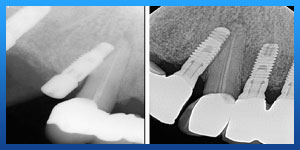Injury to adjacent teeth after Dental Implant
Damage to teeth adjacent to the implant site may occur subsequent to the insertion of implants along an improper axis or after placement of excessively large implants. This problem arises more frequently with single implants. Adjacent teeth should be evaluated before implant placement.
Pulpal and periradicular conditions such as small periapical radiolucencies, root resorption and large restorations in/near the vital pulp are often misdiagnosed. Dilacerated roots and excessive tilting in the mesiodistal direction that invades the implant space often prevent ideal placement.
The tilt of adjacent teeth should be assessed before drilling. The damage of an adjacent tooth by implant placement may cause the tooth to become non-vital, and the tooth may require subsequent endodontic treatment. This will not only result in damage to an adjacent tooth but also implant failure.

Use of a surgical guide, radiographic analysis and CT scan can help locate the implant placement, thereby avoiding damage to adjacent teeth. The angulation of adjacent teeth and dilacerations of roots must be radiographically assessed prior to implant placement.
Ideally, 1.5 to 2 mm of bone should be present between an implant and the adjacent tooth. Furthermore, inspection of a radiograph with a guide pin at a depth of 5 mm will facilitate osteotomy angulation corrections. To prevent a latent infection of the implant from the potential endodontic lesion, endodontic treatment should be performed.
Read more about : Dental implant failure rate
Read more about : German dental implant
Read more about : Dental implants cost in Iran
Read more about : Dental Implants Problems and Side Effects
Common questions
The Adjacent Tooth to the Implant Have Receding Gum and Suffer from Pain with Cold and Even Ordinary Water?
You have to get the site evaluated. The Xray of the site will show if there is any bone loss adjacent to the tooth and implant. This will indicate if the recession could be corrected and if the exposed root could be completely covered. Sometimes, 100% root coverage is not possible. Therefore, after tissue grafting, desensitizers, and resin bondings could be used to reduce sensitivity and protect the exposed root.
Why do I have pain and pressure to the adjacent teeth of my new crown/implant?
It seems the contact between the crown and your natural teeth is too tight resulting in pressure on the ligament and thus pain. This can be alleviated by removing the crown and adjusting it until its comfortable.
Source:
